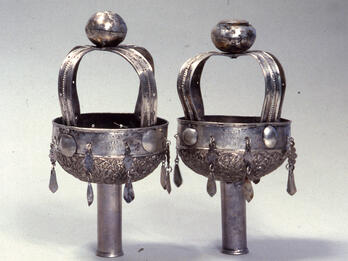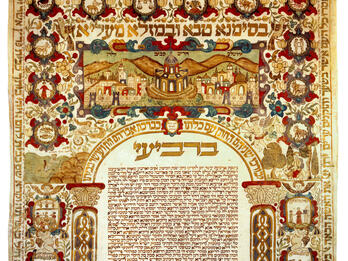Introduction: Simeon bar Tsemaḥ, Sefer ha-tashbets
[Preamble] [ . . . ]
This is both Sinai and the uprooter of mountains, the book Sefer Hatashbeṣ, which was composed by the king, the great eagle, the renowned sage, the grand prince, the light of Israel, the illuminated flame, who fulfilled the whole Torah, our teacher and rabbi, whose hand wrote and heart rejoiced, the honorable rabbi Shim‘on bar Ṣemaḥ of blessed memory, the winged.1 His Torah had been crouching among the sheepfolds for hundreds of years; no-one sought it and no-one looked for it, and every heart was melted and every hand weakened. One generation came and another went, and this Torah was guarded in a home, in the attic above it: a pearl buried and hidden within the innermost chamber. It was with twenty-four [other] books which the aforementioned rabbi had composed, which are named in Sefer Hatashbeṣ. [ . . . ]
[In Algiers, ca. 1734]
The beginning of its labor was here in the city of al-Jaza’ir, called Argel,2 may God protect it, and scatter forth its wellsprings. The eyes of all Israel were on [this book], to show them the path they might walk on, and the deeds they might do. Its waters were like cold water for a tired soul. Students found tranquility in it and immersed themselves in it, and it found favor in their eyes. [ . . . ]
It is a duty to bless the name of God who has given me life, and sustained me, and brought me to this moment, to fulfill this great commandment: to print this Torah, bringing it from potential into action, and revealing the hidden light which no eye but God’s had seen. My heart was glad in all my labor, and I said that this was my destined lot, out of all my labors. [ . . . ] How much hard suffering came to me! How many troubles! To separate them out and tell of them would take many days and nights.
[In Anatolia, ca. 1730]
I had left my homeland, and was wandering all across the world, until I came to the great city of Constantinople, exalted in thought, a praiseworthy city of great scholars and rabbis, and men of the great assembly, leaders of kindness and action. [ . . . ]
After staying for some time in this praiseworthy city, I saw some new books, which had just been printed, written by men of learning and wisdom. I said to myself that I would print this book of Torah [i.e. Sefer Hatashbeṣ], which had lain hidden for so many years, to bring relief to the souls of those saints who have already passed to the Heavenly Yeshiva. [ . . . ]
[In Livorno, ca. 1730]
And from the city of Izmir I went on a ship over the sea on my way to Livorno, may God protect it. But while I was on the ship, four large ships of Spanish men of war came down upon us, and took me and everything I had captive: my money, my clothes, and my merchandise. God tested me bitterly, and they put iron shackles on my hands and feet, and I was naked and bare, and tears ran down my cheeks. I was without clothing, provisions, or sustenance. [ . . . ]
[Returning to Algiers, ca. 1730–1734]
From the city of Livorno, may God protect it, I returned to the city of al-Jaza’ir, may God protect it: the land of my birth, and also the place where the kingly author of this book taught. I stayed with my own family, and my soul blossomed from the abundance of my joy, to see the three sons which God granted me. [ . . . ]
I bless God’s great and wondrous name, for helping and guarding me on all the journeys that I travelled. [ . . . ]
[In Tunis, 1735]
First was Tunis [ . . . ], a city filled with scholars and great rabbis. They showed great respect for me and for the rabbinic author, and they signed with lofty hands, pledging to buy some books after their printing had been completed. [ . . . ]
[In Florence, 1735–1737]
Then I returned by sea to the city of Livorno [ . . . ], a second time. I stayed there for a few days, and then went to the city which is called the height of beauty, Florence [ . . . ], the city of the Duke, and his good name, which is: Sua Altezza Reale Gian Gastone de’ Medici Gran Duca di Toscana.3 He has shown great kindness to all the Jews living under his rule, and at all times has judged them favorably, and directs all his actions for the sake of heaven. When I saw the good quality of his character, I said to myself that there we would bring this book to the altar of print. One day, I was walking in the market, and he saw me from outside the window in his house. He called to me with his servant, and I came to his call; I saw the wealth of his kingdom, and the glorious honor of his greatness. At the beginning of his speaking and questioning, he asked me for what reason I had come to his country. I told him that I had come to bring to print an ancient book of the sages of Israel. God granted me grace and favor in his eyes, and he raised me above all his other ministers who were with him, and showed me great honor, according to his rank. For three years, I stayed in the court of his palace, and he gave me great presents by the hands of his servant, and in all that time I was occupied with his work. I traveled by sea to distant lands for his service, and for the payment of my toils and labor. [ . . . ]
[In Livorno, 1737]
But after I struggled and exerted myself to print this book in the city of Florence, I was not able to, for the reasons mentioned above. I went before the duke, and begged him, saying: “if it pleases you, fulfill my request: send me to another place to perform my labor, to print this book and return to my homeland.” When he heard my words and pleas, his mercy was roused, and he told me to go in peace, to perform the work of God. So I returned to the city of Livorno [ . . . ], and spoke with the parnassim of that holy community, regarding the matter of this book. They stood on their foundation, and signed with their hands that they would receive from me a sum of books after their printing was completed [ . . . ]
[In Venice, 1737]
Now, to add to the previous support, I went to the praiseworthy and well-known city, settled in days of old, filled with scholars and rabbis and sages, people of wealth and honor and luxurious surroundings: the holy community, who accepted the Torah as Moses’s inheritance, of the city of Venice [ . . . ], which is called the height of beauty. When they heard that the book Sefer Hatashbeṣ was being brought to press, they were roused from their holy place, and contributed with all their hearts and souls. They sent my notice to the city of Livorno [ . . . ]: their signatures, pledging to buy a certain sum of these books, registered with pen on parchment, just as they write their texts and commentaries. The Torah’s crown was returned to their head. [ . . . ]
[In France, 1737]
But since I saw that the day is short, and the work is long, and the workers are lazy, I said to myself that I would print this book in the city of Amsterdam, since they are accustomed to the labor of printing, and I went there over land, through France. I first came to the city of Bordeaux [ . . . ]
[In Amsterdam, 1737]
After this, I travelled by ship over the sea to Amsterdam [ . . . ]. When I saw the place from afar, my heart began to rejoice and my face to laugh in joy. I came to that great city, Amsterdam [ . . . ], and I declared all the prayers of Hallel, and there sang songs of praise. [ . . . ]
[In London, 1737]
I also went to the glorious and well-known city of London [ . . . ]
Afterwards, I travelled to several other towns and villages among the cities of Germany, all of them worthy and good, filled with modest people of kindness and good deeds. [ . . . ] They showed me great honor, in honor of the rabbinic author, and each one signed their good name to this book. But I was wandering here and there, like a bird in the mountains, and the dove did not find rest for her foot until I returned to Amsterdam [ . . . ]
[In Amsterdam, 1739]
There I built an altar to bring this book to press, in the house of the noble, the head of the officers, the distinguished doctor, the honorable scholar Naftali Herz, son of the honorable scholar Alexander Ziskind Levi of Emden. [ . . . ] He stood beside me with all his strength, giving forth every kind of effort to labor in honor of the rabbinic author of blessed memory. He rejoiced greatly that this book was printed in his house, and gave praise and thanks to the God of Hosts, that he merited to print Sefer Hatashbeṣ which had lain hidden and buried for several hundred years, until this day, when it has been printed with fine type, pleasing to the eye.
Also, his pure-hearted wife, honorable and pleasant, whose name is Sara. [ . . . ] She offered her hands for the work of this miṣva, and did as the king commanded, stretching forth her hands to the needy. [ . . . ]
Today the world is born, for I have merited to see Sefer Hatashbeṣ in print, completed and finished. The whole world, from great to small, rejoiced, and my own heart rejoiced with them. For how many years were our eyes raised in hope! Until this day, when God has performed miracles and wonders.
Notes
Shim‘on bar Ṣemaḥ Duran (1361–1445), known as the RaShBaṢ, who fled from Majorca to Algeria in 1391 and settled in Algiers.
Algiers, al-jaza’ir in Arabic (literally “the islands,” referring to islands off the coast incorporated into the city in 1525), is called Argel in Spanish; both names are commonly found in Maghrebi Jewish writing.
“His Royal Highness, Gian Gastone de’ Medici [1671–1737], grand duke of Tuscany.”
Credits
Published in: The Posen Library of Jewish Culture and Civilization, vol. 5.




